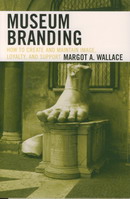review by Jody Evans

Museums compete with other museums and a diverse range of leisure attractions for exhibitions, events, government funding, corporate sponsorship, customer visitation, discretionary expenditure and consumer brand recognition. In such a challenging operating environment the importance of branding should not be underestimated. Margot A Wallace offers a practical guide for museum marketers on how to manage and develop an institution's brand touchpoints.
Chapter 1 introduces the notion that 'money follows heart' and asserts that a distinctive brand is one of the best tools to engender loyalty in visitors, donors and sponsors. This chapter also succeeds in broadening the reader's understanding of branding to include every aspect of a museum that touches the public, ranging from the logo to the café to the annual report. Chapter 2 provides a brief shopping list for museum brands. Wallace suggests that a museum brand needs a mission, personality, image, friends and supporters of like minds, exhibition design and docents, symbols and logos, and a reputation.
It is in Chapter 3 that Museum Branding provides concrete practical advice. The chapter focuses on the exhibition as a branding tool. The importance of communicating and reinforcing the museum brand through the exhibition title is discussed, as is the branding implication of floor plans, signage, exhibition catalogues, music and video. Chapter 4 introduces the notion that branding is part of a board member's accountability. Board members must be able to articulate the distinctive attributes of the museum brand if they are to successfully secure donor and sponsorship dollars. The chapter provides a checklist for museum boards starting with 'do we have a brand and can everyone define it?' to 'does every board meeting reflect and reinforce our mission?"
Chapters 5 and 6 highlight the branding roles played by education department staff, docents and volunteers. These chapters make two important points. The first relates to the internal branding opportunities when communicating with individuals in these categories. The second highlights the fact that docents and volunteers often spend the most time with visitors, acting as ambassadors for the museum brand. Chapters 7, 8 and 9 focus on the museum's membership, fundraising and corporate partnership activities. These chapters suggest that both individuals and corporations will be attracted to a strong and distinctive brand identity. Once again, the chapters provide something of a 'how to' guide with a list of ideas as to how to recruit new members and host successful fundraising events.
Chapter 10 makes some fairly self-evident suggestions for marketing professionals. The focus is on message design and the use of the tag line to articulate the brand promise. In contrast, chapters 11 to 18 provide useful insights into the branding abilities of the museum store, website, publications, audio tours, building and facilities. The emphasis is on the need for consistency across all divisions of the institution. Every point that touches the visitor is an opportunity to reinforce the brand and strengthen the relationship between museum and visitor.
The last two chapters appear to be something of an afterthought. Chapter 19 explores some issues unique to university museums. In particular, university museums must work hard to maintain their distinctive identity within the larger university entity. Chapter 20 focuses on college or university students as a future membership base for museums. The chapter suggests a number of ideas to capture the youth market including internships and guest lectures.
Overall, Museum Branding provides some useful insights into the value of branding in a museum context. The suggestions presented probably have most value for small museums and individuals new to the marketing profession. The book also has value for experienced marketers and the senior executive teams of large museums. A strong message is presented that all aspects of the museum experience can contribute to a powerful and distinctive brand. It is only through consistency and a dedicated focus on the brand promise that museums will attract a loyal visitor and donor base.
Jody Evans is a senior lecturer and program director of the PhD program at Melbourne Business School whose research interests include branding, retailing and international marketing.
